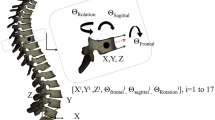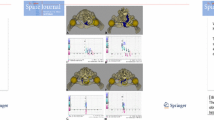Abstract
Purpose
There is insufficient information regarding axial plane characteristics of scoliosis despite its 3D nature. The posterior–anterior vertebral vector (VV) has been proposed to characterize the axial plane appearances of the thoracic scoliosis. This study aimed to highlight the importance of knowledge of axial plane features when determining fusion levels and correction techniques of thoracic curves.
Methods
Altogether, 233 thoracic curves were analyzed using the VV after proving its usability instead of 3D angles to determine axial plane parameters such as apical vertebral (APV) axial rotations, APV lateral displacement, and intervertebral rotations (IVR). K-means clustering and regression analysis were used to identify axial plane curve patterns and determine the relationship between the coronal angles and axial plane characteristics, respectively.
Results
A close correlation was found between 3D angles and VV projected angles. Eight axial plane clusters were distinct, exhibiting different lateral APV displacement toward the interacetabular axis with relatively small axial rotations and a simultaneous decrease in sagittal curves. The regression analysis showed that the correlation of coronal curve magnitude was significantly stronger (r = 0.78) with APV lateral translation than with APV axial rotation (r = 0.65).
Conclusion
Based on these findings, the primary goal of scoliosis correction should focus on minimizing lateral translation rather than eliminating axial rotation. Knowing the IVR in the axial plane helps accurately determine the limits of the structural curves. VV-based axial views can facilitate the accurate determination of the end vertebrae and selection of the appropriate correction technique of the curve.
Graphic abstract
These slides can be retrieved under Electronic Supplementary Material.









Similar content being viewed by others
References
Graf H, Hecquet J, Dubousset J (1983) Approche tridimensionnelle des déformations rachidiennes: application à l’étude du pronostic des scolioses infantiles. Rev Chir Orthop 69:407–416
Perdriolle R, Vidal J (1987) Morphology of scoliosis three-dimensional evolution. Orthopedics 110:909–915
Vrtovec T, Franjo Pernus F, Likar B (2009) A review of methods for quantitative evaluation of axial vertebral rotation. Eur Spine J 18:1079–1090. https://doi.org/10.1007/s00586-009-0914-z
Aubin C-E, Lobeau D, Labelle H, Maquinghen-Godillon AP, LeBlanc R, Dansereau J (1999) Planes of maximum deformity in the scoliotic spine. In: Stokes IAF (ed) Research into spinal deformities 2. IOS Press, Amsterdam, pp 45–48
Stagnara P, Queneau P (1953) Scolioses évolutives en période de croissance: aspects cliniques, radiologiques, propositions thérapeutiques. Rev Chir Orthop 39:378–449
Skalli W, Lavaste F, Descrimes J-L (1995) Quantification of three-dimensional vertebral rotations in scoliosis: what are the true values? Spine 20:546–553
Illés T, Tunyogi-Csapó M, Somoskeöy S (2011) Breakthrough in three-dimensional scoliosis diagnosis—significance of horizontal plane view and vertebra vectors. Eur Spine J 20:135–143. https://doi.org/10.1007/s00586-010-1566-8
Illés T, Sz Somoskeőy (2013) Comparison of scoliosis measurements based on three-dimensional vertebra vectors and conventional two-dimensional measurements: advantages in evaluation of prognosis and surgical results. Eur Spine J 22:1255–1263. https://doi.org/10.1007/s00586-012-2651-y
Somoskeöy S, Tunyogi-Csapó M, Bogyó C, Illés T (2012) Clinical validation of coronal and sagittal spinal curve measurements based on three-dimensional vertebra vector parameters. Spine J 12:960–968. https://doi.org/10.1016/j.spinee.2012.08.175
Pope MH, Stokes IA, Moreland M (1984) The biomechanics of scoliosis. Crit Rev Biomed Eng 11:157–188
Illés ST, Burkus M, Sz Somoskeöy, Lauer F, Lavaste F, Dubousset JF (2017) The horizontal plane appearances of scoliosis: what information can be obtained from top-view images? Int Orthop 41:2303–2311. https://doi.org/10.1007/s00264-017-3548-5
Lauer F (2018) MLweb: a toolkit for machine learning on the web. Neurocomputing 282:74–77. https://doi.org/10.1016/j.neucom.2017.11.069
De Mauroy J-C, Lecante C, Barral F, Pourret S (2014) Prospective study and new concepts based on scoliosis detorsion of the first 225 early in-brace radiological results with the new Lyon brace: ARTbrace. Scoliosis 9:19. https://doi.org/10.1186/1748-7161-9-19
Duong L, Mac-Thiong J-M, Cheriet F, Labelle H (2009) Three-dimensional subclassification of Lenke type 1 scoliotic curves. Spinal Disord Tech 22:135–143. https://doi.org/10.1097/BSD.0b013e31816845bc
Stokes IA (1994) Three-dimensional terminology of spinal deformity. A report presented to the Scoliosis Research Society by the Scoliosis Research Society Working Group on 3-D terminology of spinal deformity. Spine (Phila Pa 1976) 19:236–248
Halil Atmaca H, Inanmaz ME, Bal E, Caliskan I, Kose KC (2014) Axial plane analysis of Lenke 1A adolescent idiopathic scoliosis as an aid to identify curve characteristics. Spine J 14:2425–2433. https://doi.org/10.1016/j.spinee.2014.02.015
Illés TS, Burkus M, Sz Somoskeőy, Lauer F, Lavaste F, Dubousset JF (2018) Axial plane dissimilarities of two identical Lenke-type 6C scoliosis cases visualized and analyzed by vertebral vectors. Eur Spine J 27:2120–2129. https://doi.org/10.1007/s00586-018-5577-1
Drevelle X, Lafon Y, Ebermeyer E, Courtois I, Dubousset J, Skalli W (2010) Analysis of idiopathic scoliosis progression by using numerical simulation. Spine 35:E407–E412. https://doi.org/10.1097/BRS.0b013e181cb46d6
Mazda K, Ilharreborde B, Even J, Lefevre Y, Fitoussi F, Penneçot G-F (2009) Efficacy and safety of posteromedial translation for correction of thoracic curves in adolescent idiopathic scoliosis using a new connection to the spine: the Universal Clamp. Eur Spine J 18:158–169. https://doi.org/10.1007/s00586-008-0839-y
Ilharreborde B, Guy Sebag G, Wafa Skalli W, Mazda K (2013) Adolescent idiopathic scoliosis treated with posteromedial translation: radiologic evaluation with a 3D low-dose system. Eur Spine J 22:2382–2391. https://doi.org/10.1007/s00586-013-2776-7
Dubousset J (1994) Three-dimensional analysis of the scoliotic deformity. In: Weinstein SL (ed) The pediatric spine: principles and practices. Raven Press, New York, pp 479–496
Hattori T, Sakaura H, Iwasaki M, Nagamoto Y, Yoshikawa H, Sugamoto K (2011) In vivo three-dimensional segmental analysis of adolescent idiopathic scoliosis. Eur Spine J 20:1745–1750. https://doi.org/10.1007/s00586-011-1869-4
Schlösser TPC, van Stralen M, Brink RC, Chu WCW, Lam T-P, Koen L et al (2014) Three-dimensional characterization of torsion and asymmetry of the intervertebral discs versus vertebral bodies in adolescent idiopathic scoliosis. Spine 39(19):E1159–E1166. https://doi.org/10.1097/BRS.0000000000000467
Acknowledgements
We acknowledge Editage for language editing.
Funding
There is no funding source.
Author information
Authors and Affiliations
Corresponding author
Ethics declarations
Conflict of interest
Tamás S. Illés, Stig M. Jespersen, Pieter Reynders, Fabien Lauer declare that they have no conflict of interest. Jean Charles Le Huec: Consultancy: Medtronic; Tavel/accommodations/meeting expenses: Safeortho. Jean F. Dubousset: Licence: Medtronic, France.
Human rights statement
All procedures performed in studies involving human participants were in accordance with the ethical standards of the institutional and/or national research committee and with the 1964 Helsinki Declaration and its later amendments or comparable ethical standards. Clinical trial.gov registration number: NCT03418987.
Informed consent
For this type of study formal consent is not required.
Additional information
Publisher's Note
Springer Nature remains neutral with regard to jurisdictional claims in published maps and institutional affiliations.
Electronic supplementary material
Below is the link to the electronic supplementary material.
Supplementary material 2 (MP4 2292 kb)
Rights and permissions
About this article
Cite this article
Illés, T.S., Jespersen, S.M., Reynders, P. et al. Axial plane characteristics of thoracic scoliosis and their usefulness for determining the fusion levels and the correction technique. Eur Spine J 29, 2000–2009 (2020). https://doi.org/10.1007/s00586-020-06390-y
Received:
Revised:
Accepted:
Published:
Issue Date:
DOI: https://doi.org/10.1007/s00586-020-06390-y




